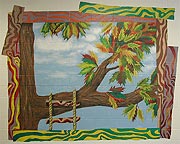
Mural at Aldersgate United Methodist
Ralph Murrell Larmann
painted by UE Department of Art
2003 |
GROUP ASSIGNMENTS
Barron, Bretz, Doades, Forbes, Howenstein, Velit
There have been a number of controversies related to the installation of public art. Find an instance where a piece of public art became controversial and discuss why it happened. Please express your group’s opinion and why you came to this conclusion.
Klene, Malone, Park, Rodman, Stanley
Art is often a mode of communicating group identity. Find an instance where a piece of art has become an identifier for a group and show why this is so. Please express your group’s opinion on how it is either positive or negative for groups to use visual images as their identifier.
Whitlow, Bergman, Clayton, Elliot, Hagedorn
Watch the movie “Birth of a Nation.” This work was regarded as one of the great masterpieces of early cinematography and art propaganda and was even praised by President Woodrow Wilson. What is your group’s impression of the movie? Why would it have been so effective in the early 20th Century? Give your groups impressions of the movie and its ramifications.
Karimov, Libertino, Moll, Rhodes, Simpson
Art forgery has sometimes been a news item of interest, especially with many masterpieces fetching large sums at auction. Find an instance, either from news or history that documents the discovery of a forgery. Should art forgery be a crime? What about Van Megeren? Give your group’s impressions of this topic.
Walsh, Batey, Carter, Durkee, Gerken
There has been a number of stories about a single artwork fetching millions of dollars at auction. Find an instance where a piece of work has sold for an incredibly high price. Relay your group’s reaction to this sale. Is the art market overpriced? Give your group’s views on this topic.
Jin, Knust, Medvedev, Pogorov, Savage, Schroeder
At the onset of the current war in Iraq, General Colin Powell gave a press conference at the United Nations that outlined the United States’ reasons for going to war. The UN covered a copy of Picasso’s “Guernica” that was to be positioned behind General Powell. Why did the UN take this action? What is the significance of the work? Discuss your groups impressions of this event and express the ramifications of that action.
Sylvester, Wilson, Blair, Denman, Flamion
In recent years issues related to copyright infringement have been in the news. In the visual arts, Jeff Koons has been criticised for his reuse of images that he claims as his own. Discuss whether Mr. Koons is stealing or has every right to reuse these images. Give your group’s opinion on this topic.
Helm, Keplar, Lyden, Owen, Robinson
The issue of fine art versus craft has been an ongoing point of contention in museums and galleries. Find a specific instance(s) where art and craft overlap. Where does craft end and fine art begin? In the instance(s) you found, how did you decide? Please express your group’s opinion on this topic.
Sloan, Welch, Bauer, Chung, Edelman
Performance art began to be accepted in the 1960’s although it had been used during the Dada movement, in Switzerland, during World War I. Find a specific instance of performance art. How does it compare to other types of performance? Can an athletic event be a form of performance art? Why or why not? Give your group’s opinion on this topic.
Gong, Johnson, Lee, Moffitt, Poudel
Art has long been seen as a form of “universal language.” Find a specific example where art or design has been used to bridge language barriers. Find information that relates to the study of visual forms as a mode of communication. Can art bridge international differences? Why or why not? Give examples. Express your group’s opinion on this topic.
|